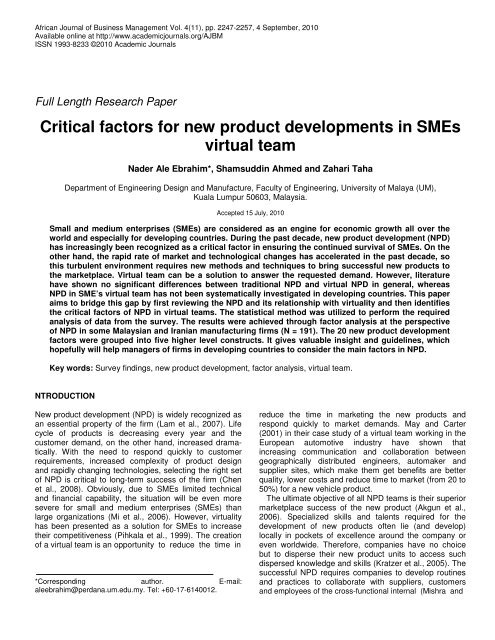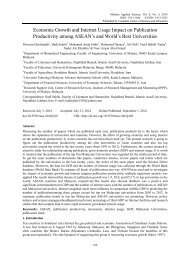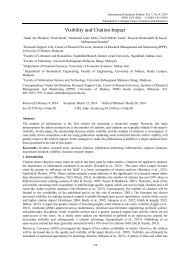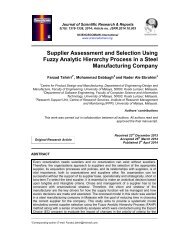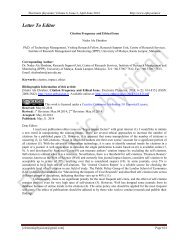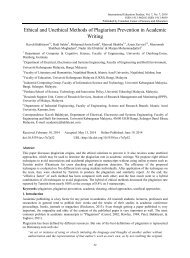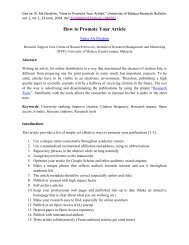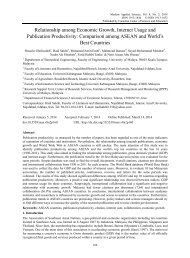Critical factors for new product developments in SMEs virtual team
Create successful ePaper yourself
Turn your PDF publications into a flip-book with our unique Google optimized e-Paper software.
African Journal of Bus<strong>in</strong>ess Management Vol. 4(11), pp. 2247-2257, 4 September, 2010<br />
Available onl<strong>in</strong>e at http://www.academicjournals.org/AJBM<br />
ISSN 1993-8233 ©2010 Academic Journals<br />
Full Length Research Paper<br />
<strong>Critical</strong> <strong>factors</strong> <strong>for</strong> <strong>new</strong> <strong>product</strong> <strong>developments</strong> <strong>in</strong> <strong>SMEs</strong><br />
<strong>virtual</strong> <strong>team</strong><br />
Nader Ale Ebrahim*, Shamsudd<strong>in</strong> Ahmed and Zahari Taha<br />
Department of Eng<strong>in</strong>eer<strong>in</strong>g Design and Manufacture, Faculty of Eng<strong>in</strong>eer<strong>in</strong>g, University of Malaya (UM),<br />
Kuala Lumpur 50603, Malaysia.<br />
Accepted 15 July, 2010<br />
Small and medium enterprises (<strong>SMEs</strong>) are considered as an eng<strong>in</strong>e <strong>for</strong> economic growth all over the<br />
world and especially <strong>for</strong> develop<strong>in</strong>g countries. Dur<strong>in</strong>g the past decade, <strong>new</strong> <strong>product</strong> development (NPD)<br />
has <strong>in</strong>creas<strong>in</strong>gly been recognized as a critical factor <strong>in</strong> ensur<strong>in</strong>g the cont<strong>in</strong>ued survival of <strong>SMEs</strong>. On the<br />
other hand, the rapid rate of market and technological changes has accelerated <strong>in</strong> the past decade, so<br />
this turbulent environment requires <strong>new</strong> methods and techniques to br<strong>in</strong>g successful <strong>new</strong> <strong>product</strong>s to<br />
the marketplace. Virtual <strong>team</strong> can be a solution to answer the requested demand. However, literature<br />
have shown no significant differences between traditional NPD and <strong>virtual</strong> NPD <strong>in</strong> general, whereas<br />
NPD <strong>in</strong> SME’s <strong>virtual</strong> <strong>team</strong> has not been systematically <strong>in</strong>vestigated <strong>in</strong> develop<strong>in</strong>g countries. This paper<br />
aims to bridge this gap by first review<strong>in</strong>g the NPD and its relationship with <strong>virtual</strong>ity and then identifies<br />
the critical <strong>factors</strong> of NPD <strong>in</strong> <strong>virtual</strong> <strong>team</strong>s. The statistical method was utilized to per<strong>for</strong>m the required<br />
analysis of data from the survey. The results were achieved through factor analysis at the perspective<br />
of NPD <strong>in</strong> some Malaysian and Iranian manufactur<strong>in</strong>g firms (N = 191). The 20 <strong>new</strong> <strong>product</strong> development<br />
<strong>factors</strong> were grouped <strong>in</strong>to five higher level constructs. It gives valuable <strong>in</strong>sight and guidel<strong>in</strong>es, which<br />
hopefully will help managers of firms <strong>in</strong> develop<strong>in</strong>g countries to consider the ma<strong>in</strong> <strong>factors</strong> <strong>in</strong> NPD.<br />
Key words: Survey f<strong>in</strong>d<strong>in</strong>gs, <strong>new</strong> <strong>product</strong> development, factor analysis, <strong>virtual</strong> <strong>team</strong>.<br />
NTRODUCTION<br />
New <strong>product</strong> development (NPD) is widely recognized as<br />
an essential property of the firm (Lam et al., 2007). Life<br />
cycle of <strong>product</strong>s is decreas<strong>in</strong>g every year and the<br />
customer demand, on the other hand, <strong>in</strong>creased dramatically.<br />
With the need to respond quickly to customer<br />
requirements, <strong>in</strong>creased complexity of <strong>product</strong> design<br />
and rapidly chang<strong>in</strong>g technologies, select<strong>in</strong>g the right set<br />
of NPD is critical to long-term success of the firm (Chen<br />
et al., 2008). Obviously, due to <strong>SMEs</strong> limited technical<br />
and f<strong>in</strong>ancial capability, the situation will be even more<br />
severe <strong>for</strong> small and medium enterprises (<strong>SMEs</strong>) than<br />
large organizations (Mi et al., 2006). However, <strong>virtual</strong>ity<br />
has been presented as a solution <strong>for</strong> <strong>SMEs</strong> to <strong>in</strong>crease<br />
their competitiveness (Pihkala et al., 1999). The creation<br />
of a <strong>virtual</strong> <strong>team</strong> is an opportunity to reduce the time <strong>in</strong><br />
*Correspond<strong>in</strong>g author. E-mail:<br />
aleebrahim@perdana.um.edu.my. Tel: +60-17-6140012.<br />
reduce the time <strong>in</strong> market<strong>in</strong>g the <strong>new</strong> <strong>product</strong>s and<br />
respond quickly to market demands. May and Carter<br />
(2001) <strong>in</strong> their case study of a <strong>virtual</strong> <strong>team</strong> work<strong>in</strong>g <strong>in</strong> the<br />
European automotive <strong>in</strong>dustry have shown that<br />
<strong>in</strong>creas<strong>in</strong>g communication and collaboration between<br />
geographically distributed eng<strong>in</strong>eers, automaker and<br />
supplier sites, which make them get benefits are better<br />
quality, lower costs and reduce time to market (from 20 to<br />
50%) <strong>for</strong> a <strong>new</strong> vehicle <strong>product</strong>.<br />
The ultimate objective of all NPD <strong>team</strong>s is their superior<br />
marketplace success of the <strong>new</strong> <strong>product</strong> (Akgun et al.,<br />
2006). Specialized skills and talents required <strong>for</strong> the<br />
development of <strong>new</strong> <strong>product</strong>s often lie (and develop)<br />
locally <strong>in</strong> pockets of excellence around the company or<br />
even worldwide. There<strong>for</strong>e, companies have no choice<br />
but to disperse their <strong>new</strong> <strong>product</strong> units to access such<br />
dispersed knowledge and skills (Kratzer et al., 2005). The<br />
successful NPD requires companies to develop rout<strong>in</strong>es<br />
and practices to collaborate with suppliers, customers<br />
and employees of the cross-functional <strong>in</strong>ternal (Mishra and
2248 Afr. J. Bus. Manage.<br />
Shah, 2009). Consequently, companies f<strong>in</strong>d that the<br />
<strong>in</strong>ternal development of all technologies necessary <strong>for</strong><br />
<strong>new</strong> <strong>product</strong>s and processes are difficult or impossible.<br />
They must <strong>in</strong>creas<strong>in</strong>gly acquire technology from external<br />
sources (Stock and Tatikonda, 2004). Virtualization <strong>in</strong><br />
NDP has recently begun to make serious progress due to<br />
<strong>developments</strong> <strong>in</strong> technology-<strong>virtual</strong>ity <strong>in</strong> NPD now is<br />
technically possible (Leenders et al., 2003). Virtual NPD<br />
<strong>in</strong> <strong>SMEs</strong> is <strong>in</strong> its <strong>in</strong>fancy <strong>in</strong> develop<strong>in</strong>g countries, and little<br />
research has been done on the <strong>in</strong>troduction of the NPD <strong>in</strong><br />
<strong>SMEs</strong> through a <strong>virtual</strong> <strong>team</strong>. So, we <strong>for</strong>med the topic<br />
that is somewhat lack<strong>in</strong>g <strong>in</strong> the literature as a research<br />
gap.<br />
The ma<strong>in</strong> objective of this paper is to present a model<br />
of critical <strong>factors</strong> of NPD <strong>in</strong> small and medium enterprises<br />
<strong>in</strong> develop<strong>in</strong>g countries. The rest of the paper is<br />
organized as follows:<br />
The ma<strong>in</strong> concepts of <strong>new</strong> <strong>product</strong> development; reviews<br />
recent study on the relationship between NPD and<br />
<strong>virtual</strong>ity; explores the importance of <strong>SMEs</strong>; presents the<br />
relationship between <strong>SMEs</strong> and <strong>virtual</strong> <strong>team</strong>; describes<br />
the research methodology; presents data collection, data<br />
analysis and discussion; and f<strong>in</strong>ally, it concludes the<br />
paper with some perspectives.<br />
WHAT IS NEW PRODUCT DEVELOPMENT (NPD)?<br />
The literature provided a number of def<strong>in</strong>itions <strong>for</strong> what<br />
constitute a <strong>new</strong> <strong>product</strong> development (NPD). Product<br />
development def<strong>in</strong>ition is used by different researchers <strong>in</strong><br />
slightly different ways (Ale Ebrahim et al., 2009b).<br />
Generally, it is the process that covers <strong>product</strong> design,<br />
pro-duction system design, <strong>product</strong> <strong>in</strong>troduction<br />
processes and start of <strong>product</strong>ion (Johansen, 2005).<br />
Loch and Kavadias (2008) <strong>in</strong> the “Handbook of New<br />
Product Development Management” def<strong>in</strong>e NPD to<br />
“consists of the activities of the firm that lead to a stream<br />
of <strong>new</strong> or changed <strong>product</strong> market offer<strong>in</strong>gs over time.<br />
This <strong>in</strong>cludes the generation of opportunities, their<br />
selection and trans<strong>for</strong>mation <strong>in</strong>to artifacts (manufactured<br />
<strong>product</strong>s) and activities (services) offered to customers<br />
and the <strong>in</strong>stitutionalization of improvements <strong>in</strong> the NPD<br />
activities themselves”. Accord<strong>in</strong>g to the <strong>product</strong><br />
development and management association (PDMA)<br />
glossary <strong>for</strong> <strong>new</strong> <strong>product</strong> development <strong>in</strong> the PDMA tool<br />
book 3 <strong>for</strong> <strong>new</strong> <strong>product</strong> development (Griff<strong>in</strong> and<br />
Somermeyer, 2007), NPD was def<strong>in</strong>ed as “the overall<br />
process of strategy, organization, concept generation,<br />
<strong>product</strong> and market<strong>in</strong>g plan creation and evaluation, and<br />
commercialization of a <strong>new</strong> <strong>product</strong>. Also, it is frequently<br />
referred to as <strong>product</strong> development”. Krishnan and Ulrich<br />
(2001) def<strong>in</strong>ed “<strong>product</strong> development as the trans<strong>for</strong>mation<br />
of a market opportunity and a set of assumptions<br />
about <strong>product</strong> technology <strong>in</strong>to a <strong>product</strong> available <strong>for</strong><br />
sale”. NPD has been described <strong>in</strong> a general <strong>for</strong>m and<br />
there is no specified def<strong>in</strong>ition <strong>for</strong> <strong>new</strong> <strong>product</strong> development<br />
of <strong>SMEs</strong> <strong>virtual</strong> <strong>team</strong> <strong>in</strong> develop<strong>in</strong>g countries, which<br />
mean what is NPD, <strong>in</strong> <strong>SMEs</strong> <strong>virtual</strong> <strong>team</strong>, supposed to be<br />
<strong>in</strong> develop<strong>in</strong>g countries? This paper aims to extract the<br />
ma<strong>in</strong> <strong>factors</strong> of NPD <strong>in</strong> selective cases.<br />
NPD AND VIRTUALITY<br />
Given the complexities <strong>in</strong>volved <strong>in</strong> organiz<strong>in</strong>g face-to-face<br />
<strong>in</strong>teractions among <strong>team</strong> members and the<br />
advancements <strong>in</strong> electronic communication technologies,<br />
firms are turn<strong>in</strong>g toward employ<strong>in</strong>g <strong>virtual</strong> NPD <strong>team</strong>s<br />
(Badr<strong>in</strong>arayanan and Arnett, 2008). However, <strong>in</strong><strong>for</strong>mation<br />
technology (IT) improves NPD flexibility (Durmusoglu and<br />
Calantone, 2006). Ozer (2004) discussed that the <strong>in</strong>ternet<br />
facilitates and improves collaborations and thus<br />
<strong>in</strong>creases the per<strong>for</strong>mance of <strong>new</strong> <strong>product</strong>s. Given the<br />
result<strong>in</strong>g differences <strong>in</strong> time zones and physical distances<br />
<strong>in</strong> such ef<strong>for</strong>ts, <strong>virtual</strong> NPD projects are receiv<strong>in</strong>g<br />
<strong>in</strong>creas<strong>in</strong>g attention (McDonough et al., 2001). The use of<br />
<strong>virtual</strong> <strong>team</strong>s to develop <strong>new</strong> <strong>product</strong>s is grow<strong>in</strong>g rapidly<br />
and can be dependent on organizations <strong>in</strong> ma<strong>in</strong>ta<strong>in</strong><strong>in</strong>g a<br />
competitive advantage. On the other hand, competitive<br />
strategies are <strong>for</strong>c<strong>in</strong>g companies to deploy their NPD<br />
resources globally, thus mak<strong>in</strong>g collocated NPD <strong>team</strong>s<br />
prohibitively expensive and logistically difficult to manage<br />
(Susman et al., 2003). Susman et al. (2003) noted that<br />
research will <strong>in</strong>creas<strong>in</strong>gly focus on geographically<br />
dispersed NPD <strong>team</strong>s as their number will grow faster<br />
than collocated NPD <strong>team</strong>s. McDonough et al. (2001)<br />
argued that NPD <strong>team</strong>s are grow<strong>in</strong>g very fast, whereas<br />
<strong>virtual</strong>ity affects the creative per<strong>for</strong>mance of NPD <strong>team</strong>s<br />
(Leenders et al., 2003). For example, Cisco has created<br />
the Cisco Collaboration Centre of Excellence to achieve<br />
its vision. Despite this <strong>in</strong>dustry attention, much is not yet<br />
understood about how to effectively collaborate <strong>virtual</strong>ity<br />
to facilitate NPD (Susman and Majchrzak, 2003).<br />
Some studies (Mart<strong>in</strong>ez-Sanchez et al., 2006) emphasized<br />
the challenges and difficulties experienced by<br />
<strong>virtual</strong> and conventional (<strong>for</strong> <strong>new</strong> <strong>product</strong> development)<br />
<strong>team</strong>s, which were not significantly different, although<br />
greater than the challenges and difficulties experienced<br />
by the <strong>in</strong>-house <strong>team</strong>s. NPD <strong>in</strong> SME’s <strong>virtual</strong> <strong>team</strong> has<br />
not been systematically <strong>in</strong>vestigated <strong>in</strong> literature. As a<br />
consequence, literature only, has not shown significant<br />
differences between traditional and <strong>virtual</strong> NPD <strong>in</strong><br />
general. However, this paper aims to bridge this gap.<br />
SMALL AND MEDIUM ENTERPRISES (SMES)<br />
<strong>SMEs</strong> are a major part of the <strong>in</strong>dustrial economies<br />
(Eikebrokk and Olsen, 2007) and their survival and<br />
growth have there<strong>for</strong>e, be<strong>in</strong>g a prom<strong>in</strong>ent issue. The<br />
contributions of <strong>SMEs</strong> to employment and the countries’<br />
gross domestic <strong>product</strong> (GDP) are highly significant
Ale Ebrahim et al. 2249<br />
(Kotelnikov, 2007). Acs et al. (1997) argued that small<br />
firms are <strong>in</strong>deed the eng<strong>in</strong>es of global economic growth,<br />
whereas small and medium enterprises (<strong>SMEs</strong>) play an<br />
important role <strong>in</strong> promot<strong>in</strong>g economic development. Many<br />
economists believe that the wealth of nations and the<br />
growth of their economies strongly depend on the<br />
per<strong>for</strong>mance of their <strong>SMEs</strong> (Schröder, 2006). In many<br />
developed and develop<strong>in</strong>g countries, small and mediumsized<br />
enterprises (<strong>SMEs</strong>) are the unsung heroes that<br />
br<strong>in</strong>g stability to the national economy and help buffer the<br />
shocks that come with the boom and bust of economic<br />
cycles. <strong>SMEs</strong> also serve as the key eng<strong>in</strong>e beh<strong>in</strong>d<br />
equaliz<strong>in</strong>g <strong>in</strong>come disparity among workers (Choi, 2003).<br />
<strong>SMEs</strong> seem to be appropriate units when behav<strong>in</strong>g like<br />
network nodes because of their lean structure, adaptability<br />
to market evolution, active <strong>in</strong>volvement of versatile<br />
human resources, ability to establish a sub-contract<strong>in</strong>g<br />
relation and good technological level of their <strong>product</strong>s<br />
(Mezgar et al., 2000). In light of the above, <strong>SMEs</strong> have<br />
advantages <strong>in</strong> terms of flexibility, reaction time and<br />
<strong>in</strong>novation capacity that make them central actors <strong>in</strong> the<br />
<strong>new</strong> economy (Raymond and Croteau, 2006).<br />
<strong>SMEs</strong> def<strong>in</strong>ition<br />
There are many accepted def<strong>in</strong>itions of <strong>SMEs</strong> and the<br />
classifications vary from <strong>in</strong>dustry to <strong>in</strong>dustry and from<br />
country to country (O’Regan and Ghobadian, 2004).<br />
Table 1 illustrates a summary of <strong>SMEs</strong> def<strong>in</strong>ition <strong>in</strong> the<br />
manufactur<strong>in</strong>g sector of selected countries. In most<br />
countries that are listed <strong>in</strong> Table 1, the def<strong>in</strong>ition is<br />
applicable to all sectors of the enterprises. Different countries<br />
adopt different criteria such as employment, sales or<br />
<strong>in</strong>vestment <strong>for</strong> def<strong>in</strong><strong>in</strong>g small and medium enterprises<br />
(Ayyagari et al., 2007). At present, there seems to be no<br />
consensus on the def<strong>in</strong>ition of <strong>SMEs</strong> (Deros et al., 2006).<br />
In the absence of a def<strong>in</strong>itive classification, an agreement<br />
has developed around the European Commission (EC)<br />
criteria <strong>for</strong> SME classification (O’Regan and Ghobadian,<br />
2004). This def<strong>in</strong>ition adopts a quantitative approach<br />
emphasiz<strong>in</strong>g “tangible” criteria, employee numbers (up to<br />
250 employees), turnover and balance sheet statistics<br />
(Tiwari and Buse, 2007). While turnover and balance<br />
sheet statistics are part of the criteria, the overrid<strong>in</strong>g consideration<br />
<strong>in</strong> practice appears to be an employee number<br />
based. Even if all three criteria were af<strong>for</strong>ded equal<br />
consideration, it could be argued that the def<strong>in</strong>ition fails to<br />
take <strong>in</strong>to account the attributes of a modern day small<br />
firm than to the medium-sized firm. The case studies<br />
employed here are <strong>SMEs</strong> <strong>in</strong> the Malaysian and Iranian<br />
manufactur<strong>in</strong>g sector, which are chosen accord<strong>in</strong>g to the<br />
EC def<strong>in</strong>ition of <strong>SMEs</strong> (Figure 1).<br />
<strong>SMEs</strong> and <strong>virtual</strong> <strong>team</strong><br />
Past literature often hypothesized that <strong>SMEs</strong> were not<br />
<strong>in</strong>novated <strong>for</strong>mally <strong>in</strong> recognized ways, and that they<br />
made much more extensive use of external l<strong>in</strong>kages<br />
(La<strong>for</strong>et and Tann, 2006; Hoffman et al., 1998). However,<br />
the SME is not a scaled-down version of a large<br />
company. It has different characteristics that dist<strong>in</strong>guish it<br />
from large corporations and can of course change across<br />
different countries and cultures. Moreover, they are<br />
generally <strong>in</strong>dependent, multi-task<strong>in</strong>g, cash-limited and<br />
based on personal relationships and <strong>in</strong><strong>for</strong>mality, as well<br />
as be<strong>in</strong>g actively managed by the owners, highly<br />
personalized, largely local <strong>in</strong> their area of operation and<br />
largely dependent on <strong>in</strong>ternal sources to f<strong>in</strong>ance growth<br />
(Perr<strong>in</strong>i et al., 2007). To survive <strong>in</strong> the global economy,<br />
<strong>SMEs</strong> have to improve their <strong>product</strong>s and processes by<br />
exploit<strong>in</strong>g their <strong>in</strong>tellectual capital <strong>in</strong> a dynamic network of<br />
knowledge-<strong>in</strong>tensive relations <strong>in</strong>side and outside their<br />
borders (Corso et al., 2003). So if small firms want to<br />
make a step change <strong>in</strong> their technological and <strong>in</strong>novational<br />
base, they may have to reth<strong>in</strong>k their approach to<br />
cooperation (Hanna and Walsh, 2002). <strong>SMEs</strong> need to<br />
focus on core competencies <strong>for</strong> efficiency matters;<br />
however, they need to cooperate with external partners to<br />
compensate <strong>for</strong> other competencies and resources. This<br />
is especially the case <strong>in</strong> the field of <strong>new</strong> <strong>product</strong><br />
development, where <strong>SMEs</strong> face specific problems <strong>in</strong><br />
comparison to large firms (Pullen et al., 2008).<br />
Despite the widespread publicity of <strong>in</strong><strong>for</strong>mation technology,<br />
the application of <strong>in</strong>ternet technology to upgrade<br />
and enhance the <strong>product</strong> design and bus<strong>in</strong>ess operation<br />
by most enterprises, especially <strong>for</strong> the small and medium<br />
sized enterprises, is still at its <strong>in</strong>fancy (Zhan et al., 2003).<br />
The <strong>SMEs</strong> are one of the sectors that have a strong<br />
potential to benefit from advances <strong>in</strong> <strong>in</strong><strong>for</strong>mation and<br />
communication technologies (ICTs) and the adaptation of<br />
<strong>new</strong> bus<strong>in</strong>ess modes of operation (Miles et al., 2000).<br />
The use of ICTs can be considered as key <strong>factors</strong> <strong>for</strong><br />
<strong>in</strong>novation and entrepreneurship; however, it is a must <strong>for</strong><br />
<strong>SMEs</strong> to <strong>in</strong>novate ICTs (Redoli et al., 2008). More so, It is<br />
especially urgent <strong>for</strong> <strong>SMEs</strong> to construct a service plat<strong>for</strong>m<br />
of network to speed up the <strong>product</strong> development process<br />
(Lan et al., 2004). Collaboration is particularly critical<br />
when <strong>SMEs</strong> are <strong>in</strong>volved with the aim of develop<strong>in</strong>g <strong>new</strong><br />
<strong>product</strong>s (Romero et al., 2008).<br />
The success of developed countries can be attributed<br />
to <strong>factors</strong> relat<strong>in</strong>g to the emergence of <strong>new</strong> bus<strong>in</strong>ess<br />
technologies and cultures, such as <strong>virtual</strong> technology.<br />
This constituted the soft-technology complex that<br />
provided the environment <strong>for</strong> <strong>in</strong>novation and the effective<br />
application of technologies (Zhouy<strong>in</strong>g, 2005). Develop<strong>in</strong>g<br />
countries are, on the other hand, characterized by the<br />
absence of soft technology and limited abilities to make<br />
effective and efficient use of the technologies they obta<strong>in</strong><br />
through a variety of transfer mechanisms, and to <strong>in</strong>novate<br />
and compete <strong>in</strong> the global market. Many <strong>SMEs</strong> have difficulties<br />
achiev<strong>in</strong>g successful <strong>in</strong>novation, despite hav<strong>in</strong>g<br />
significant <strong>in</strong>vestment <strong>in</strong> research and development<br />
(O’Regan et al., 2006). Gassmann and Keupp (2007)<br />
found that managers of <strong>SMEs</strong> should <strong>in</strong>vest less <strong>in</strong> tangible
2250 Afr. J. Bus. Manage.<br />
Table 1. Def<strong>in</strong>ition of <strong>SMEs</strong> <strong>in</strong> the manufactur<strong>in</strong>g sector of selected countries (Adopted from Ale Ebrahim et al., 2009a).<br />
Country<br />
European<br />
Commission (EC)<br />
criteria<br />
Category of<br />
enterprise<br />
Small<br />
Number of employee Turnover Other measure<br />
10 - 50 Less than € 10 (13.5 USD)<br />
million turnover<br />
Balance sheet total: Less than<br />
€ 10 (13.5 USD) million<br />
balance sheet total<br />
European<br />
Commission (EC)<br />
criteria<br />
Medium Fewer than 250 Less than € 50 (67.6 USD)<br />
million turnover<br />
Balance sheet total: Less than<br />
€ 43 (58.2 USD) million<br />
balance<br />
sheet total<br />
Indonesia Small 5 – 19 Annual value of sales of a<br />
maximum of IDR1 billion<br />
(110,000 USD)<br />
Indonesia Medium 20 – 99 Annual value of sales of more<br />
than IDR1 billion, but less than<br />
IDR50 billion (5.5 million USD)<br />
Iran Small Less than 10*<br />
Less than 50**<br />
Iran Medium 10 - 100*<br />
50 - 250**<br />
Japan Less than 300 ¥100 (1.1 USD) million assets<br />
South Korea Less than 300<br />
Malaysia Small 5 to 50 Between RM 250,000<br />
(75,000 USD) and less than<br />
RM 10 (3 USD) million<br />
Malaysia Medium 50 to 150 Between RM 10 (3 USD)<br />
million and RM 25 (7.5 USD)<br />
million<br />
Philipp<strong>in</strong>es Small 10 - 99 Between PHP 3 - 15 million<br />
(66,000 -330,000 USD) asset<br />
Philipp<strong>in</strong>es Medium 100 - 199 Between PHP 15 - 100 million<br />
(330,000 - 2.2 million USD)<br />
asset<br />
*USD selected as a reference currency and the conversion is approximate.<br />
assets, but more <strong>in</strong> those areas that will directly generate<br />
their future competitive advantage (<strong>for</strong> example, <strong>in</strong> R&D<br />
to generate knowledge, and <strong>in</strong> their employees’ creativity<br />
to stimulate <strong>in</strong>cremental <strong>in</strong>novations <strong>in</strong> already exist<strong>in</strong>g<br />
technologies). Moreover, the web-because of its easy<br />
access to large numbers of potential customers at<br />
reasonable cost may especially aid smaller companies<br />
that have not enjoyed the same national reach or f<strong>in</strong>ancial<br />
resources as larger companies <strong>for</strong> market research<br />
(Buyukozkan et al., 2007). Levy et al. (2003) state that<br />
<strong>SMEs</strong> are knowledge creators but are poor <strong>in</strong> knowledge<br />
retention. They need to be proactive <strong>in</strong> knowledge shar<strong>in</strong>g
Ale Ebrahim et al. 2251<br />
Figure 1. European Commission (EC) criteria <strong>for</strong> classification of SME (used <strong>in</strong> this research).<br />
Figure 2. Research framework.<br />
knowledge shar<strong>in</strong>g arrangements <strong>in</strong> order to recognize<br />
that knowledge has value and that the value added is<br />
derived from knowledge exchange (Egbu et al., 2005).<br />
RESEARCH METHODOLOGY<br />
This research applied a statistical approach based on factor<br />
analysis and research framework (Figure 2). Factor analysis is a<br />
technique that attempts to identify underly<strong>in</strong>g variables or <strong>factors</strong><br />
that expla<strong>in</strong> the pattern of correlations with<strong>in</strong> a set of observed<br />
variables. Factor analysis is often used <strong>in</strong> data reduction to identify<br />
a small number of <strong>factors</strong> that expla<strong>in</strong> most of the variance that is<br />
observed <strong>in</strong> a much larger number of manifest variables. It is also<br />
suitable <strong>for</strong> analyz<strong>in</strong>g the patterns of complex, multidimensional<br />
relationships encountered by researchers (Fathian et al., 2008).<br />
Based on the ma<strong>in</strong> <strong>factors</strong> <strong>in</strong> NPD, 20 questions were derived<br />
from the literature review and an onl<strong>in</strong>e questionnaire was<br />
designed. To help disentangle the concepts of <strong>new</strong> <strong>product</strong><br />
development <strong>in</strong> the <strong>virtual</strong> <strong>team</strong> of <strong>SMEs</strong>, 20 <strong>in</strong>dividual criteria were<br />
asked from respondents (Table 2). These criteria have been<br />
grouped together through factor analysis to <strong>for</strong>m the critical <strong>factors</strong><br />
of NPD <strong>in</strong> <strong>virtual</strong> <strong>team</strong>s. The respondent asked a series of<br />
questions such as NPD 1: “Based on your organizations, is a <strong>new</strong><br />
<strong>product</strong>/process development the use of th<strong>in</strong>gs already known<br />
(reverse Eng<strong>in</strong>eer<strong>in</strong>g)? “<br />
Data collection<br />
The research target was manufactur<strong>in</strong>g <strong>SMEs</strong> <strong>in</strong> Malaysia (M) and<br />
Iran (I) that are us<strong>in</strong>g the <strong>virtual</strong> <strong>team</strong> <strong>in</strong> their organization. In order<br />
to understand the viewpo<strong>in</strong>ts of <strong>SMEs</strong> on NPD, an onl<strong>in</strong>e<br />
questionnaire has been sent to relevant <strong>SMEs</strong> <strong>in</strong> both countries.<br />
The rapid expansion of <strong>in</strong>ternet users has given web-based surveys<br />
the potential to become a powerful tool <strong>in</strong> survey research (Sills and<br />
Song, 2002). Denscombe (2006) f<strong>in</strong>d<strong>in</strong>gs encourage social researchers<br />
to use web-based questionnaires with confidence, and the<br />
data produced by web-based questionnaires are equivalent to that<br />
produced by paper-based questionnaires. Other authors emphasized<br />
that the data provided by the <strong>in</strong>ternet methods are, at least, of<br />
good quality as those provided by traditional paper-and-pencil methods<br />
(Deutskens et al., 2006). However, m<strong>in</strong>or differences occur<br />
between the two survey methods. Onl<strong>in</strong>e respondents provided<br />
more improvement suggestions (Deutskens et al., 2006) which<br />
tended to be slightly longer than those from the paper version. As a<br />
result, the differences are not statistically significant (Denscombe,<br />
2008).<br />
The ma<strong>in</strong> sampl<strong>in</strong>g target was the manag<strong>in</strong>g director, R&D<br />
manager, the <strong>new</strong> <strong>product</strong> development manager, project and design<br />
manager and appropriate people who were most familiar with<br />
the NPD <strong>in</strong> the firm. For better understand<strong>in</strong>g, the questionnaire<br />
has been prepared <strong>in</strong>to different languages, that is, English and<br />
Persian. Consequently, the Iranian respondents could select either<br />
English or Persian version of the questionnaire. A total number of<br />
3,625 e-mails have been sent to relevant <strong>SMEs</strong> and 686 of them<br />
clicked the onl<strong>in</strong>e web page and answered the questionnaire. Out<br />
of 686 respondents, 190 <strong>SMEs</strong> responded completely and the rest<br />
answered partially. Table 3 summarized the onl<strong>in</strong>e survey data<br />
collection. Only 121 firms met the criteria of <strong>SMEs</strong> def<strong>in</strong>ition <strong>in</strong> this<br />
research, so the rest of the respondents deducted from the factor<br />
analysis. A cross-tabulation descriptive statistics was employed to<br />
f<strong>in</strong>d the frequency and relationship between the country and
2252 Afr. J. Bus. Manage.<br />
Table 2. Criteria (20) of the NPD.<br />
Question<br />
NPD1<br />
NPD2<br />
NPD3<br />
NPD4<br />
NPD5<br />
NPD6<br />
NPD7<br />
NPD8<br />
NPD9<br />
NPD10<br />
NPD11<br />
NPD12<br />
NPD13<br />
NPD14<br />
NPD15<br />
NPD16<br />
NPD17<br />
NPD18<br />
NPD19<br />
NPD20<br />
Criteria<br />
The entire R&D activities<br />
The use of th<strong>in</strong>gs already known (Reverse Eng<strong>in</strong>eer<strong>in</strong>g)<br />
Mak<strong>in</strong>g use of exist<strong>in</strong>g technologies (Adaptation)<br />
Increase efficiency of <strong>product</strong><br />
Meet the role and regulation<br />
Improvement <strong>in</strong> <strong>product</strong> functionality/quality<br />
Improvements <strong>in</strong> elements of <strong>product</strong> technologies<br />
Major <strong>in</strong>novation <strong>in</strong> <strong>product</strong> technologies<br />
Major <strong>in</strong>novation <strong>in</strong> <strong>product</strong>s as a whole<br />
Creation of <strong>new</strong> <strong>product</strong> concepts<br />
Improvement <strong>in</strong> the <strong>product</strong> process<br />
Reduction <strong>in</strong> quality problems<br />
Surprise or delight customers<br />
Replac<strong>in</strong>g <strong>product</strong>s that are phased out<br />
Extend<strong>in</strong>g <strong>product</strong> range<br />
Reduc<strong>in</strong>g <strong>product</strong>ion lead times<br />
Ga<strong>in</strong><strong>in</strong>g <strong>new</strong> markets or market share<br />
Reduc<strong>in</strong>g labour costs<br />
Reduc<strong>in</strong>g material consumption<br />
Reduc<strong>in</strong>g energy consumption<br />
Table 3. Summarized onl<strong>in</strong>e survey data collection.<br />
Numbers of e-mails sent<br />
to Malaysian (M) <strong>SMEs</strong><br />
Numbers of e-mails<br />
sent to Iranian (I) <strong>SMEs</strong><br />
Total e-mails<br />
sent to <strong>SMEs</strong><br />
Total responses (click<br />
the onl<strong>in</strong>e web page)<br />
Total responses/<br />
sent (%)<br />
Total<br />
completed<br />
Total completed/<br />
sent (%))<br />
Total completed/<br />
received (%)<br />
2068 1557 3625 686 18.9 190 5.2 27.7<br />
<strong>virtual</strong>ity as illustrated <strong>in</strong> Table 4.<br />
Data analysis<br />
In the case of reliability analysis, Cronbach’s<br />
(1951) alpha was employed to measure the<br />
<strong>in</strong>ternal consistency of the 20 <strong>factors</strong>. A reliability<br />
test was carried out to ensure that the research<br />
f<strong>in</strong>d<strong>in</strong>g have the ability to provide consistent<br />
results. Cronbach’s alpha <strong>for</strong> the 20 NPD <strong>factors</strong><br />
was found with<strong>in</strong> acceptable limits and was found<br />
to be 0.926, which means that there was a high<br />
reliability <strong>for</strong> the designed questions. In order to<br />
conclude whether the partial correlation of<br />
variables was small, the authors used the Kaiser-<br />
Meyer-Olk<strong>in</strong> (KMO) measure of sampl<strong>in</strong>g adequacy<br />
and Bartlett’s Chi-square test of sphericity<br />
(Fathian et al., 2008). Table 5 summarized the<br />
results of KMO, which is 0.863 and the significant<br />
value of Bartlett’s test <strong>in</strong> less than 0.05, which
Ale Ebrahim et al. 2253<br />
Table 4. Cross-tabulation between country and <strong>virtual</strong>ity.<br />
Virtuality NPD<br />
Yes No<br />
Total<br />
Count 50 18 68<br />
Country<br />
Iran % with<strong>in</strong> country 73.5 26.5 100.0<br />
Count 19 34 53<br />
Malaysia % with<strong>in</strong> country 35.8 64.2 100.0<br />
Count 69 52 121<br />
Total % with<strong>in</strong> country 57.0 43.0 100.0<br />
Table 5. KMO and Bartlett's test results.<br />
Kaiser-Meyer-Olk<strong>in</strong> measure of sampl<strong>in</strong>g adequacy 0.863<br />
Bartlett's test of sphericity<br />
Approx. chi-square 961.993<br />
df 190<br />
Sig. 0.000<br />
means there was a good correlation.<br />
An exploratory factor analysis was conducted on<br />
20 NPD <strong>factors</strong> us<strong>in</strong>g a pr<strong>in</strong>ciple component analysis with<br />
a varimax rotation and an Eigenvalue of 1 as the cut-off<br />
po<strong>in</strong>t (Akgün et al., 2008) and an absolute value of a<br />
factor load<strong>in</strong>g that is greater than 0.5 (Fathian et al.,<br />
2008). The items and their factor load<strong>in</strong>gs, after<br />
exploratory factor analysis, Eigenvalue and percentage of<br />
variance expla<strong>in</strong>ed, appear <strong>in</strong> Tables 6 and 7. The 20<br />
<strong>factors</strong> were grouped <strong>in</strong>to five higher level constructs,<br />
which had an Eigenvalue greater than one.<br />
DISCUSSION<br />
The authors attempted to identify and named the<br />
confirmed <strong>factors</strong> based on the pr<strong>in</strong>ciple of be<strong>in</strong>g concise<br />
without los<strong>in</strong>g clarity of mean<strong>in</strong>g. After extract<strong>in</strong>g the<br />
higher level constructs, variables with higher load<strong>in</strong>gs are<br />
considered more important and have greater <strong>in</strong>fluence on<br />
the name of selected reduced <strong>factors</strong>. The names and<br />
contents of five derived <strong>factors</strong> are discussed.<br />
Factor 1<br />
It consists of NPD 17 to 20, which are “ga<strong>in</strong><strong>in</strong>g <strong>new</strong><br />
markets or market share“, “reduc<strong>in</strong>g labor costs”,<br />
“reduc<strong>in</strong>g materials consumption” and “reduc<strong>in</strong>g energy<br />
consumption”, respectively. This factor is named “process<br />
features”.<br />
Factor 2<br />
It consists of NPD 4, 5, 12 and 13, which are “<strong>in</strong>crease<br />
efficiency of <strong>product</strong>”, “meet the role and regulation”,<br />
“reduction <strong>in</strong> quality problems” and “surprise or delight<br />
customers”, respectively. S<strong>in</strong>ce NPD 12 has higher<br />
load<strong>in</strong>g (0.794), this factor was named “customer<br />
demand“.<br />
Factor 3<br />
It consists of NPD 2, 3, 7 and 15, which are “the use of<br />
th<strong>in</strong>gs already known (reverse Eng<strong>in</strong>eer<strong>in</strong>g)”, “mak<strong>in</strong>g<br />
use of exist<strong>in</strong>g technologies (adaptation)”, “improvements<br />
<strong>in</strong> elements of <strong>product</strong> technologies” and “extend<strong>in</strong>g<br />
<strong>product</strong> range”, respectively. This factor is named<br />
“technology features”.<br />
Factor 4<br />
It consists of NPD 6, 8, 10 and 11, which are “improvement<br />
<strong>in</strong> <strong>product</strong> functionality/quality”, “major <strong>in</strong>novation <strong>in</strong><br />
<strong>product</strong> technologies”, “creation of <strong>new</strong> <strong>product</strong> concepts”<br />
and “improvement <strong>in</strong> the <strong>product</strong> process”, respectively.<br />
This factor is named “<strong>in</strong>novative process”.<br />
Factor 5<br />
It consists of NPD 1, 9, 14 and 16, which are “the entire<br />
R&D activities”, “major <strong>in</strong>novation <strong>in</strong> <strong>product</strong>s as a whole”,
2254 Afr. J. Bus. Manage.<br />
Table 6. Factor analysis results.<br />
Component<br />
Initial Eigen values<br />
Rotation sums of squared load<strong>in</strong>gs<br />
Total % of variance Cumulative % Total % of variance Cumulative %<br />
1 9.683 48.417 48.417 3.370 16.851 16.851<br />
2 1.643 8.214 56.631 3.022 15.108 31.959<br />
3 1.202 6.011 62.641 3.012 15.058 47.017<br />
4 1.112 5.558 68.200 2.934 14.670 61.687<br />
5 1.000 5.001 73.201 2.303 11.514 73.201<br />
6 0.812 4.061 77.262<br />
7 0.767 3.837 81.099<br />
8 0.605 3.026 84.125<br />
9 0.546 2.729 86.854<br />
10 0.465 2.324 89.178<br />
11 0.400 1.998 91.176<br />
12 0.342 1.712 92.888<br />
13 0.322 1.609 94.497<br />
14 0.229 1.145 95.642<br />
15 0.225 1.123 96.764<br />
16 0.212 1.061 97.826<br />
17 0.149 0.746 98.572<br />
18 0.108 0.538 99.110<br />
19 0.091 0.455 99.565<br />
20 0.087 0.435 100.000<br />
Extraction method: Pr<strong>in</strong>cipal component analysis.<br />
Table 7. Rotated component matrix sorted by size.<br />
Component (Cronbach’s alpha) t<br />
1 (.850) 2 (.821) 3 (.749) 4 (.790) 5 (.735)<br />
NPD19 0.792 0.134 0.248 0.218 0.019<br />
NPD18 0.762 0.287 0.232 0.103 0.227<br />
NPD20 0.715 0.250 0.325 0.142 0.135<br />
NPD17 0.515 0.364 -0.052 0.282 0.343<br />
NPD12 0.278 0.794 0.313 0.155 0.203<br />
NPD4 0.238 0.784 0.135 -0.288 0.069<br />
NPD5 0.203 0.754 0.345 0.105 0.237<br />
NPD13 0.379 0.462 0.280 0.275 0.453<br />
NPD7 0.144 0.141 0.721 0.512 0.089<br />
NPD2 0.372 0.218 0.706 0.148 -0.002<br />
NPD3 0.169 0.258 0.670 0.165 0.219<br />
NPD15 0.130 0.296 0.653 0.220 0.457<br />
NPD10 0.149 -0.059 0.322 0.721 0.228<br />
NPD8 0.186 0.205 0.332 0.710 0.040<br />
NPD6 0.206 0.393 0.136 0.668 0.041<br />
NPD11 0.528 0.308 -0.016 0.580 0.171<br />
NPD14 0.126 0.117 0.542 0.267 0.649<br />
NPD9 -0.016 0.237 0.180 0.546 0.604<br />
NPD16 0.569 0.034 0.090 0.170 0.591<br />
NPD1 0.380 0.335 0.114 -0.133 0.569<br />
Extraction method: Pr<strong>in</strong>cipal component analysis; Rotation method: Varimax with<br />
Kaiser Normalization.
Ale Ebrahim et al. 2255<br />
Meet the role and<br />
regulation<br />
Increase efficiency<br />
of <strong>product</strong><br />
Reduc<strong>in</strong>g energy<br />
consumption<br />
Reduc<strong>in</strong>g<br />
materials<br />
consumption<br />
Reverse<br />
Eng<strong>in</strong>eer<strong>in</strong>g<br />
Extend<strong>in</strong>g <strong>product</strong><br />
range<br />
Customer<br />
Demand<br />
Process<br />
Features<br />
Technology<br />
Features<br />
Surprise or delight<br />
customers<br />
Reduction <strong>in</strong><br />
quality problems<br />
Reduc<strong>in</strong>g labor<br />
costs<br />
Ga<strong>in</strong><strong>in</strong>g <strong>new</strong><br />
markets or market<br />
share<br />
Adaptation<br />
Improvements <strong>in</strong><br />
elements of <strong>product</strong><br />
technologies<br />
NPD <strong>in</strong> <strong>SMEs</strong> Virtual Team<br />
Improvement <strong>in</strong><br />
<strong>product</strong> quality<br />
Major <strong>in</strong>novation<br />
<strong>in</strong> <strong>product</strong><br />
technologies<br />
Reduc<strong>in</strong>g energy<br />
consumption<br />
Reduc<strong>in</strong>g<br />
materials<br />
consumption<br />
Innovative<br />
Process<br />
Introduce New<br />
Product<br />
Creation of <strong>new</strong><br />
<strong>product</strong> concepts<br />
Improvement <strong>in</strong><br />
<strong>product</strong> process<br />
Reduc<strong>in</strong>g labor<br />
costs<br />
Ga<strong>in</strong><strong>in</strong>g <strong>new</strong><br />
markets or market<br />
share<br />
Figure 3. A conceptual model of NPD <strong>in</strong> <strong>SMEs</strong> <strong>virtual</strong> <strong>team</strong> (based on research results).<br />
“replac<strong>in</strong>g <strong>product</strong>s that are be<strong>in</strong>g phased out” and<br />
“reduc<strong>in</strong>g <strong>product</strong>ion lead times”, respectively. S<strong>in</strong>ce<br />
NPD 14 has been a higher load<strong>in</strong>g (0.649), this factor<br />
was named “<strong>in</strong>troduce <strong>new</strong> <strong>product</strong>“.<br />
All the a<strong>for</strong>ementioned <strong>factors</strong> are summarized <strong>in</strong> Figure<br />
3. This <strong>new</strong> conceptual model is based on data analysis<br />
of the survey f<strong>in</strong>d<strong>in</strong>gs. The conceptual model provides an<br />
overview of NPD understand<strong>in</strong>g <strong>in</strong> <strong>SMEs</strong> (the ones which<br />
are familiar with <strong>virtual</strong>ity) of some selected develop<strong>in</strong>g<br />
countries. Although more than half of the respondents are<br />
work<strong>in</strong>g on <strong>virtual</strong> <strong>team</strong> bases <strong>for</strong> <strong>new</strong> <strong>product</strong><br />
<strong>developments</strong>, the <strong>virtual</strong> <strong>team</strong> application <strong>in</strong> <strong>SMEs</strong> is still<br />
<strong>in</strong> <strong>in</strong>fancy. Slightly, more than 80% of the <strong>SMEs</strong> have not<br />
received an e-mail <strong>in</strong>vitation to participate <strong>in</strong> an onl<strong>in</strong>e<br />
survey (Table 3).<br />
<strong>SMEs</strong>, especially <strong>in</strong> develop<strong>in</strong>g countries, severe from<br />
the lack of resources and manpower (Ale Ebrahim et al.,<br />
2009a) and as a result, the ability to consistently select<br />
the best <strong>factors</strong> to <strong>in</strong>vestigate, is there<strong>for</strong>e, vitally<br />
important to firms <strong>in</strong> the said countries. Hence, the<br />
manager of NPD <strong>team</strong> <strong>in</strong> <strong>SMEs</strong> has to optimize the <strong>new</strong><br />
<strong>product</strong> process. This <strong>new</strong> conceptual model works as a<br />
tool to help a manager of the NPD <strong>team</strong> to focus on the<br />
major and important issues <strong>in</strong> NPD process, which lead<br />
to an <strong>in</strong>crease <strong>in</strong> the efficiency of the procedure <strong>for</strong> <strong>new</strong><br />
<strong>product</strong>s. For academic researchers, this study<br />
contributes to a theoretical understand<strong>in</strong>g of the <strong>factors</strong><br />
that promote the diffusion of NPD <strong>in</strong> <strong>SMEs</strong>.<br />
Conclusion<br />
Factor analysis provides direct <strong>in</strong>sight <strong>in</strong>to the<br />
<strong>in</strong>terrelationships between 20 variables and reduced it to<br />
five components. The first factor which is “process<br />
features” and which is a comb<strong>in</strong>ation of “ga<strong>in</strong><strong>in</strong>g <strong>new</strong><br />
markets or market share“, “reduc<strong>in</strong>g labour costs”,<br />
“reduc<strong>in</strong>g materials consumption” and “reduc<strong>in</strong>g energy<br />
consumption”, is more important than the rest four<br />
<strong>factors</strong>. So managers of firms <strong>in</strong> develop<strong>in</strong>g countries<br />
should consider the ma<strong>in</strong> <strong>factors</strong> <strong>in</strong> NPD. Customers demand<br />
(people) and technology features are respectively<br />
important after process issues. There<strong>for</strong>e, go<strong>in</strong>g along with
2256 Afr. J. Bus. Manage.<br />
Ebrahim et al. (2009c) recent research, people and<br />
process are more important <strong>in</strong> the <strong>virtual</strong> <strong>team</strong> than about<br />
technology.<br />
Table 3 shows slightly, that above 18% of <strong>SMEs</strong> have<br />
received the onl<strong>in</strong>e survey e-mail <strong>in</strong>vitation. So it can<br />
conclude that most <strong>SMEs</strong> <strong>in</strong> the selected develop<strong>in</strong>g<br />
countries are still develop<strong>in</strong>g a <strong>new</strong> <strong>product</strong> <strong>in</strong> the<br />
traditional way, and they are not adopted with <strong>new</strong> <strong>in</strong><strong>for</strong>mation<br />
and communication technologies. As <strong>virtual</strong> NPD<br />
<strong>in</strong> <strong>SMEs</strong> is <strong>in</strong> its <strong>in</strong>fancy <strong>in</strong> develop<strong>in</strong>g countries, it seems<br />
to be a necessary start <strong>for</strong> the <strong>in</strong>troduction of the <strong>virtual</strong><br />
<strong>team</strong> <strong>in</strong> the <strong>SMEs</strong>. The first step is perceived as NPD <strong>in</strong><br />
this <strong>new</strong> environment, which is explored <strong>in</strong> this study.<br />
This study is probably the first to present a conceptual<br />
model <strong>for</strong> the NPD issue <strong>in</strong> <strong>SMEs</strong> of the selected<br />
develop<strong>in</strong>g countries. The future research needs to<br />
<strong>in</strong>vestigate the model and verify it by a larger sample of<br />
<strong>SMEs</strong> from different sectors, s<strong>in</strong>ce this study was limited<br />
to the manufactur<strong>in</strong>g sector. In a larger sample, it is<br />
possible to compare the results between Iran and<br />
Malaysian <strong>SMEs</strong>.<br />
ACKNOWLEDGEMENTS<br />
This research was funded by a grant from the University<br />
of Malaya (Grant No. PS404/2009C) and the authors<br />
acknowledge this support. In addition, the authors are<br />
grateful to the editors and two anonymous reviewers <strong>for</strong><br />
their helpful and <strong>in</strong>sightful contributions on the first<br />
version of this document.<br />
REFERENCES<br />
Acs ZJ, Morck R, Shaver JM, Yeung B (1997). The Internationalization<br />
of Small and Medium-Sized Enterprises: A Policy Perspective. Small<br />
Bus. Econ. 9: 7–20.<br />
Akgun AE, Dayan M, Benedetto AD (2008). New <strong>product</strong> development<br />
<strong>team</strong> <strong>in</strong>telligence: Antecedents and consequences Info. Manage. 45,<br />
221-226.<br />
Akgun AE, Lynn GS, Yilmaz C (2006). Learn<strong>in</strong>g process <strong>in</strong> <strong>new</strong> <strong>product</strong><br />
development <strong>team</strong>s and effects on <strong>product</strong> success: A sociocognitive<br />
perspective. Ind. Mark. Manage. 35: 210 – 224.<br />
Ale Ebrahim N, Ahmed S, Taha Z (2009a). Virtual R & D <strong>team</strong>s <strong>in</strong> small<br />
and medium enterprises: A literature review. Sci. Res. Essay. 4:<br />
1575–1590.<br />
Ale Ebrahim N, Ahmed S, Taha Z (2009b). Virtual Teams <strong>for</strong> New<br />
Product Development – An Innovative Experience <strong>for</strong> R&D<br />
Eng<strong>in</strong>eers. Eur. J. Educ. Stud. 1: 109-123.<br />
Ale Ebrahim N, Ahmed S, Taha Z (2009c). Virtual Teams: a Literature<br />
Review. Aus. J. Basic Appl. Sci. 3: 2653-2669.<br />
Ayyagari M, Beck T, Demirguc-Kunt A (2007). Small and Medium<br />
Enterprises Across the Globe. Small Bus. Econ. 29: 415-434.<br />
Badr<strong>in</strong>arayanan V, Arnett DB (2008). Effective <strong>virtual</strong> <strong>new</strong> <strong>product</strong><br />
development <strong>team</strong>s: an <strong>in</strong>tegrated framework. J. Bus. Ind. Mark. 23:<br />
242-248.<br />
Buyukozkan G, Baykasoglu A, Dereli T (2007). Integration of Internet<br />
and web-based tools <strong>in</strong> <strong>new</strong> <strong>product</strong> development process. Prod.<br />
Plann<strong>in</strong>g Control. 18: 44-53.<br />
Chen HH, Kang YK, X<strong>in</strong>g X, Lee AHI, Tong Y (2008). Develop<strong>in</strong>g <strong>new</strong><br />
<strong>product</strong>s with knowledge management methods and process<br />
development management <strong>in</strong> a network. Comp. Ind. 59: 242–253.<br />
Choi TY (2003). Korea's Small and Medium-Sized Enterprises: Unsung<br />
Heroes or Economic Laggards? Acad. Manage. Exec. 17: 128-129.<br />
Corso M, Mart<strong>in</strong>i A, Paolucci E, Pellegr<strong>in</strong>i L (2003). Knowledge<br />
management configurations <strong>in</strong> Italian small-to-medium enterprises.<br />
Integrated Manufactur<strong>in</strong>g Syst. 14: 46-56.<br />
Cronbach L (1951). Coefficient alpha and the <strong>in</strong>ternal structure of tests.<br />
Psychometrika. 16, 297-334.<br />
Denscombe M (2006). Web-Based Questionnaires and the Mode Effect:<br />
An Evaluation Based on Completion Rates and Data Contents of<br />
Near-Identical Questionnaires Delivered <strong>in</strong> Different Modes. Soc. Sci.<br />
Comp. Rev. 24: 246-254.<br />
DENSCOMBE, M. 2008. The Length of Responses to Open-Ended<br />
Questions: A Comparison of Onl<strong>in</strong>e and Paper Questionnaires <strong>in</strong><br />
Terms of a Mode Effect. Soc. Sci. Comp. Rev. 26: 359-368.<br />
Deros BM, Yusof SM, Salleh AM (2006). A benchmark<strong>in</strong>g<br />
implementation framework <strong>for</strong> automotive manufactur<strong>in</strong>g <strong>SMEs</strong>.<br />
Benchmark<strong>in</strong>g: An Int. J. 13: 396-430.<br />
Deutskens E, De Ruyter K, Wetzels M (2006). An assessment of<br />
equivalence between onl<strong>in</strong>e and mail surveys <strong>in</strong> service research. J.<br />
Serv. Res. 8: 346-355.<br />
Durmusoglu SS, Calantone RJ (2006). Is more <strong>in</strong><strong>for</strong>mation technology<br />
better <strong>for</strong> <strong>new</strong> <strong>product</strong> development? Prod. Brand Manage. 15: 435-<br />
441.<br />
Egbu CO, Hari S, Renukappa SH (2005). Knowledge management <strong>for</strong><br />
susta<strong>in</strong>able competitiveness <strong>in</strong> small and medium survey<strong>in</strong>g<br />
practices. Structural Survey 23: 7-21.<br />
Eikebrokk TR, Olsen DH (2007). An empirical <strong>in</strong>vestigation of<br />
competency <strong>factors</strong> affect<strong>in</strong>g e-bus<strong>in</strong>ess success <strong>in</strong> European <strong>SMEs</strong>.<br />
Info. Manage. 44: 364-383<br />
Fathian M, Akhavan P, Hoorali M (2008). E-read<strong>in</strong>ess assessment of<br />
non-profit ICT <strong>SMEs</strong> <strong>in</strong> a develop<strong>in</strong>g country: The case of Iran.<br />
Technovation. 28: 578-590.<br />
Gassmann O, Keupp MM (2007). The competitive advantage of early<br />
and rapidly <strong>in</strong>ternationalis<strong>in</strong>g <strong>SMEs</strong> <strong>in</strong> the biotechnology <strong>in</strong>dustry: A<br />
knowledge-based view. J. World Bus. 42: 350-366.<br />
Griff<strong>in</strong> A, Somermeyer S (2007). The PDMA Tool Book 3 <strong>for</strong> New<br />
Product Development, John Wiley & Sons, Inc.<br />
Hanna V, Walsh K (2002). Small Firm Networks: A Successful<br />
Approach to Innovation?. R&D Manage. 32: 201-207.<br />
Hoffman K, Parejo M, Bessant J, Perren L (1998). Small firms, R&D,<br />
technology and <strong>in</strong>novation <strong>in</strong> the UK: a literature review.<br />
Technovation 18: 39-55<br />
Johansen K (2005). Collaborative Product Introduction with<strong>in</strong> Extended<br />
Enterprises. PhD, L<strong>in</strong>köp<strong>in</strong>gs Universitet.<br />
Kotelnikov V (2007). Small and Medium Enterprises and ICT. In: HAK-<br />
SU, K. (ed.) Asia-Pacific Development In<strong>for</strong>mation Programme<br />
(UNDP-APDIP) e-Primers <strong>for</strong> the In<strong>for</strong>mation Economy, Society and<br />
Polity. Bangkok: UNDP Regional Centre.<br />
Kratzer J, Leenders R, Engelen JV (2005). Keep<strong>in</strong>g Virtual R&D Teams<br />
Creative. Industrial Research Institute, Inc., March-April, 13-16.<br />
Krishnan V, Ulrich KT (2001). Product Development Decisions: A<br />
Review of the Literature. Manage. Sci. 47: 1-21.<br />
La<strong>for</strong>et S, Tann, J (2006). Innovative characteristics of small<br />
manufactur<strong>in</strong>g firms. J. Small Bus. Enterprise Dev. 13: 363 - 380.<br />
Lam PK, Ch<strong>in</strong> KS, Yang JB, Liang W (2007). Self-assessment of<br />
conflict management <strong>in</strong> client-supplier collaborative <strong>new</strong> <strong>product</strong><br />
development. Ind. Manage. Data Syst. 107: 688 - 714.<br />
Lan, H., D<strong>in</strong>g, Y., Hong, J., Huang, H. & LU, B. 2004. A web-based<br />
manufactur<strong>in</strong>g service system <strong>for</strong> rapid <strong>product</strong> development. Comp.<br />
Ind. 54: 51 - 67<br />
Leenders RTAJ, Engelen JMLV, Kratzer J (2003). Virtuality,<br />
communication, and <strong>new</strong> <strong>product</strong> <strong>team</strong> creativity: a social network<br />
perspective. J. Eng. Technol. Manage. 20: 69–92.<br />
Levy M, Loebbecke C, Powell P (2003). <strong>SMEs</strong>, competition and<br />
knowledge shar<strong>in</strong>g: the role of <strong>in</strong><strong>for</strong>mation systems. Eur. J. Info. Syst.<br />
12: 3-17<br />
Loch C, Kavadias S (2008). Handbook of New Product Development<br />
Management, Butterworth-He<strong>in</strong>emann is an impr<strong>in</strong>t of Elsevier.<br />
Mart<strong>in</strong>ez-Sanchez A, Perez-Perez M, De-Luis-Carnicer P, Vela-Jimenez<br />
MJ (2006). Telework<strong>in</strong>g and <strong>new</strong> <strong>product</strong> development. Eur. J.<br />
Innovation Manage. 9: 202-214.<br />
May A, Carter C (2001). A case study of <strong>virtual</strong> <strong>team</strong> work<strong>in</strong>g <strong>in</strong> the<br />
European automotive <strong>in</strong>dustry. Int. J. Ind. Ergon. 27: 171-186.
Ale Ebrahim et al. 2257<br />
Mcdonough EF, Kahn KB, Barczak G (2001). An <strong>in</strong>vestigation of the<br />
use of global, <strong>virtual</strong>, and collocated <strong>new</strong> <strong>product</strong> development<br />
<strong>team</strong>s. Int. J. Prod. Econ. 18: 110–120.<br />
Mezgar I, Kovacs GL, Paganelli P (2000). Co-operative <strong>product</strong>ion<br />
plann<strong>in</strong>g <strong>for</strong> small- and medium-sized enterprises. Int. J. Prod. Econ.<br />
64: 37-48.<br />
Mi X, Shen W, Zhao W (2006). Research on Internet-Based System<br />
Architecture <strong>for</strong> Collaborative Product Development. Computer<br />
Supported Cooperative Work <strong>in</strong> Design II. Spr<strong>in</strong>ger Berl<strong>in</strong> /<br />
Heidelberg.<br />
Miles RE, Snow CC, Miles G (2000). The Future.org Long Range<br />
Plann<strong>in</strong>g, 33: 300-321.<br />
Mishra AA, Shah R (2009). In union lies strength: Collaborative<br />
competence <strong>in</strong> <strong>new</strong> <strong>product</strong> development and its per<strong>for</strong>mance<br />
effects. J. Oper. Manage. 27: 324-338.<br />
O’regan N, Ghobadian A (2004). Test<strong>in</strong>g the homogeneity of <strong>SMEs</strong> -<br />
The impact of size on managerial and organisational processes. Eur.<br />
Bus. Rev. 16: 64-79.<br />
O’regan N., Ghobadian, A. & Sims, M. (2006). Fast track<strong>in</strong>g <strong>in</strong>novation<br />
<strong>in</strong> manufactur<strong>in</strong>g <strong>SMEs</strong> Technovation, 26: 251-261<br />
Ozer M (2004). The role of the Internet <strong>in</strong> <strong>new</strong> <strong>product</strong> per<strong>for</strong>mance: A<br />
conceptual <strong>in</strong>vestigation. Ind. Mark. Manage. 33: 355– 369.<br />
Perr<strong>in</strong>i F, Russo A, Tencati A (2007). CSR Strategies of <strong>SMEs</strong> and<br />
Large Firms. Evidence from Italy. J. Bus. Ethics. 74: 285-300.<br />
Pihkala T, Varamaki E, Vesala<strong>in</strong>en J (1999). Virtual organization and<br />
the <strong>SMEs</strong>: a review and model development. Entrepreneurship Reg.<br />
Dev. 11: 335 - 349.<br />
Pullen, A., Weerd-Nederhof PD, Groen A, Fisscher O (2008).<br />
Configurations of external SME characteristics to expla<strong>in</strong> differences<br />
<strong>in</strong> <strong>in</strong>novation per<strong>for</strong>mance. High Technology Small Firms Conference<br />
Twente University, Netherlands.<br />
Raymond L, Croteau AM (2006). Enabl<strong>in</strong>g the strategic development of<br />
<strong>SMEs</strong> through advanced manufactur<strong>in</strong>g systems A configurational<br />
perspective. Ind. Manage. Data Systems. 106: 1012-1032.<br />
Redoli J, Mompó R, García-Díez J, López-Coronado M (2008). A model<br />
<strong>for</strong> the assessment and development of Internet-based <strong>in</strong><strong>for</strong>mation<br />
and communication services <strong>in</strong> small and medium enterprises<br />
Technovation. 28: 424-435.<br />
Romero F, Company P, Agost MJ, Vila C (2008). Activity modell<strong>in</strong>g <strong>in</strong> a<br />
collaborative ceramic tile design cha<strong>in</strong>: an enhanced IDEF0<br />
approach. Res. Eng. Design. 19: 1-20.<br />
Schröder HH (2006). Past, Present and Future of Knowledge<br />
Integration. In: JETTER, A., Schröder HH, Kraaijenbr<strong>in</strong>k J, Wijnhoven<br />
F (eds.) Knowledge Integration-The Practice of Knowledge<br />
Management <strong>in</strong> Small and Medium Enterprises. Physica-Verlag HD.<br />
Sills SJ, Song C (2002). Innovations <strong>in</strong> Survey Research: An Application<br />
of Web-Based Surveys. Soc. Sci. Comput. Rev. 20: 22-30.<br />
Stock GN, Tatikonda MV (2004). External technology <strong>in</strong>tegration <strong>in</strong><br />
<strong>product</strong> and process development. Int. J. Oper. Prod. Manage. 24:<br />
642-665.<br />
Susman GI, Gray BL, Perry J, Blair CE (2003). Recognition and<br />
reconciliation of differences <strong>in</strong> <strong>in</strong>terpretation of misalignments when<br />
collaborative technologies are <strong>in</strong>troduced <strong>in</strong>to <strong>new</strong> <strong>product</strong><br />
development <strong>team</strong>s. J. Eng. Technol. Manage. 20: 141–159.<br />
Susman GI, Majchrzak A (2003). Research issues <strong>in</strong> knowledge<br />
management and <strong>virtual</strong> collaboration <strong>in</strong> <strong>new</strong> <strong>product</strong> development:<br />
an <strong>in</strong>troductory essay. J. Eng. Technol. Manage. 20: 1-5.<br />
Tiwari R, Buse S (2007). Barriers to Innovation <strong>in</strong> <strong>SMEs</strong>: Can the<br />
Internationalization of R&D Mitigate Their Effects? Proceed<strong>in</strong>gs of the<br />
First European Conference on Knowledge <strong>for</strong> Growth: Role and<br />
Dynamics of Corporate R&D (CONCORD 2007). Seville, Spa<strong>in</strong>.<br />
Zhan HF, Lee WB, Cheung CF, Kwok SK, Gu XJ (2003). A web-based<br />
collaborative <strong>product</strong> design plat<strong>for</strong>m <strong>for</strong> dispersed network<br />
manufactur<strong>in</strong>g. J. Mat. Process. Technol. 138: 600-604.<br />
Zhouy<strong>in</strong>g J (2005). Globalization, technological competitiveness and the<br />
‘catch-up’ challenge <strong>for</strong> develop<strong>in</strong>g countries: some lessons of<br />
experience. Int. J. Technol. Manage. Susta<strong>in</strong>. Dev. 4: 35-46.


